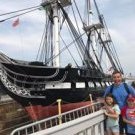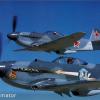-
Posts
1,267 -
Joined
-
Last visited
Reputation Activity
-
 AnobiumPunctatum got a reaction from Eddie in Triton cross section by Anguirel -1:48
AnobiumPunctatum got a reaction from Eddie in Triton cross section by Anguirel -1:48
Anguriel,
looks really good. I think it is very helpful to let a little bit more timber on both sides of the frame. So you can sand the whole section in one step and egalize small differences without makeing the frames to small durig this step.
-
 AnobiumPunctatum reacted to dvm27 in HMS Pegasus 1776 by Trussben - 1:48 - Swan-class sloop based on TFFM
AnobiumPunctatum reacted to dvm27 in HMS Pegasus 1776 by Trussben - 1:48 - Swan-class sloop based on TFFM
Wise move, Ben. I had the same issue when trying to drill my hawse hawse in v.1. At least you have them properly located now and finish by hand. I had little success doing them the way David recommends in the book (adding them to each hawse timber before gluing them in place). That requires a level of precision above my pay grade!
Looking forward to next years continued progress.
-
 AnobiumPunctatum reacted to Trussben in HMS Pegasus 1776 by Trussben - 1:48 - Swan-class sloop based on TFFM
AnobiumPunctatum reacted to Trussben in HMS Pegasus 1776 by Trussben - 1:48 - Swan-class sloop based on TFFM
Thanks for the likes.
Fun was had today setting up the mill and drilling the hawse holes at the correct 10 degree angle as measured off the plans. They were only drilled out to 4" at the moment, the rest of the way will be done with a tapered reamer, but this has given the correct position and angle of the holes.
-
 AnobiumPunctatum reacted to EdT in Young America 1853 by EdT - FINISHED - extreme clipper
AnobiumPunctatum reacted to EdT in Young America 1853 by EdT - FINISHED - extreme clipper
Young America - extreme clipper 1853
Part 191 – Decking the Fore Top
Just when I was having fun with wood, more ironwork was needed. The first picture shows the addition of iron reinforcing for the rim in the area where the topmast shrouds will be positioned.
The iron in this case is .010" copper, snipped to the shape of the top, glued on with CA. It was then trimmed to shape and polished, at least on the port side in the picture.
The next picture shows the frame temporarily wedged on to the hounds.
The iron rim caps have been drilled through the index points. The wooden rim cap that will cover the plank ends is being glued on in this picture. In the next picture, planking of the top is proceeding.
Planks are 6" x 2 ½" thick. The 9" fairlead planks have been drilled and are being installed. The next picture shows the top with all planking installed.
The holes in the rim have been converted to slots that will pass the deadeye straps. Also, the two iron fid plates on which the topmast fid will rest have been installed. Work on the fore mast cap has begun and is shown in the picture.
The next picture shows the top again placed on the hounds.
In the next picture the top has been trimmed out and the ironwork blackened.
There are six eyebolts under the forward rim for the fore course bunt and leech lines. The two on the top of the rim will be hooked to the tackles of the upper topsail sheets. An interesting location for these. Belaying points for the added upper topsails may have been difficult to find on the crowded deck rails. The next picture shows the aft side.
The eyebolt just aft of the mast will secure the main topgallant stay. There should be just sufficient space between this and the mast for the shroud collars. The shackled eyebolt on the aft crosstree will anchor the standing lift on the spencer gaff. There may need to be a bracket added forward of the topmast to secure an iron stay for the lower topsail yard that will be fixed at the cap.
Last post before the holidays. All the best to everyone in this special season.
Ed
-
 AnobiumPunctatum got a reaction from Eddie in Triton cross section by Anguirel -1:48
AnobiumPunctatum got a reaction from Eddie in Triton cross section by Anguirel -1:48
I normaly use treenails. I put them in before installing the frames. I am not sure if brass or copper wire will work in the same way. But it's easy to test. Cut one futtock a little bit oversized. Put it some wire and treenails and sand them to the correct size. So you will see if your idea´and material work as exspected.
-
 AnobiumPunctatum reacted to navymast in Burford 1722 by navymast - scale 1:48 - Suspended
AnobiumPunctatum reacted to navymast in Burford 1722 by navymast - scale 1:48 - Suspended
A lot of time is spent figuring out the details. Books help a bit. But almost always something missing. I have to spend a lot of time to think. As many times to view different information. I drew a line on the model body. Different parts of the painted in a different color. Red - something that will be removed.
-

-
 AnobiumPunctatum reacted to navymast in Burford 1722 by navymast - scale 1:48 - Suspended
AnobiumPunctatum reacted to navymast in Burford 1722 by navymast - scale 1:48 - Suspended
Fashion piece - paper and wood. [/url] 156_21807879.jpg'>
-
 AnobiumPunctatum got a reaction from mtaylor in Triton cross section by Anguirel -1:48
AnobiumPunctatum got a reaction from mtaylor in Triton cross section by Anguirel -1:48
I normaly use treenails. I put them in before installing the frames. I am not sure if brass or copper wire will work in the same way. But it's easy to test. Cut one futtock a little bit oversized. Put it some wire and treenails and sand them to the correct size. So you will see if your idea´and material work as exspected.
-
 AnobiumPunctatum got a reaction from FriedClams in Young America 1853 by EdT - FINISHED - extreme clipper
AnobiumPunctatum got a reaction from FriedClams in Young America 1853 by EdT - FINISHED - extreme clipper
Brilliant
-
 AnobiumPunctatum got a reaction from ChadB in Triton cross section by Anguirel -1:48
AnobiumPunctatum got a reaction from ChadB in Triton cross section by Anguirel -1:48
Anguriel,
looks really good. I think it is very helpful to let a little bit more timber on both sides of the frame. So you can sand the whole section in one step and egalize small differences without makeing the frames to small durig this step.
-
 AnobiumPunctatum reacted to druxey in HM Cutter Cheerful 1806 by Erik W - 1:48 scale
AnobiumPunctatum reacted to druxey in HM Cutter Cheerful 1806 by Erik W - 1:48 scale
Mark out first, then prick the spots with a sharp point. That way the drill point won't 'wander' off the marks.
-

-
 AnobiumPunctatum got a reaction from mtaylor in Triton cross section by Anguirel -1:48
AnobiumPunctatum got a reaction from mtaylor in Triton cross section by Anguirel -1:48
Anguriel,
looks really good. I think it is very helpful to let a little bit more timber on both sides of the frame. So you can sand the whole section in one step and egalize small differences without makeing the frames to small durig this step.
-
 AnobiumPunctatum got a reaction from tkay11 in Triton cross section by Anguirel -1:48
AnobiumPunctatum got a reaction from tkay11 in Triton cross section by Anguirel -1:48
Anguriel,
looks really good. I think it is very helpful to let a little bit more timber on both sides of the frame. So you can sand the whole section in one step and egalize small differences without makeing the frames to small durig this step.
-
 AnobiumPunctatum got a reaction from Canute in Triton cross section by Anguirel -1:48
AnobiumPunctatum got a reaction from Canute in Triton cross section by Anguirel -1:48
Anguriel,
looks really good. I think it is very helpful to let a little bit more timber on both sides of the frame. So you can sand the whole section in one step and egalize small differences without makeing the frames to small durig this step.
-

-
 AnobiumPunctatum got a reaction from mtaylor in Young America 1853 by EdT - FINISHED - extreme clipper
AnobiumPunctatum got a reaction from mtaylor in Young America 1853 by EdT - FINISHED - extreme clipper
Brilliant
-
 AnobiumPunctatum got a reaction from Jack12477 in Young America 1853 by EdT - FINISHED - extreme clipper
AnobiumPunctatum got a reaction from Jack12477 in Young America 1853 by EdT - FINISHED - extreme clipper
Brilliant
-
 AnobiumPunctatum reacted to EdT in Young America 1853 by EdT - FINISHED - extreme clipper
AnobiumPunctatum reacted to EdT in Young America 1853 by EdT - FINISHED - extreme clipper
Young America - extreme clipper 1853
Part 190 – Framing the Fore Top
It was nice to get back to some pure – well almost pure – woodworking on the tops. There will be ironwork involved, but not in this post. The first picture shows the first step, pinning the 9" x 9" crosstrees to the drawing.
Pins were placed in holes that are centered on the slots that will pass the deadeye straps for the topmast shrouds. They are conveniently located to index the pieces. In the next picture the 9" x 18" trestletrees have been mortised and fitted.
The port trestletree is being glued, held down by pin clamps. The next picture shows the basic framework positioned on the hounds.
The spacing of the members provides just sufficient clearance to go over the masthead bands. The top framing is temporarily wedged forward of the mast to check and adjust the level on the top face of the hounds. The top is aft-heavy. The next picture shows the rim being formed.
This was made in a two piece laminate to facilitate bending and minimize spring-back after the two dried pieces were glued. The rim is shown on the drawing in the next picture.
The lap joints in the trees have been cut in this picture. In the next picture the laps have been cut in the rim.
Indexing holes were drilled in the rim before the joinery was done. Finally, the assembled framing.
Next, planking and triming out the top.
Ed
-
 AnobiumPunctatum got a reaction from mtaylor in HMS Thorn by Kevin Kenny - 1:48 scale - Swan-class - David Antscherl practium
AnobiumPunctatum got a reaction from mtaylor in HMS Thorn by Kevin Kenny - 1:48 scale - Swan-class - David Antscherl practium
Kevin,
thanks that you brought these details with your small mistake back in my mind. I hope that my rising wood will help me to place the frames accuratly.
-
 AnobiumPunctatum reacted to ChadB in Triton Cross Section by ChadB (Chach_86) - FINISHED
AnobiumPunctatum reacted to ChadB in Triton Cross Section by ChadB (Chach_86) - FINISHED
3. Wood Selection
I got down to the business of deciding the What, Where, and What Size of the cross section. I started by figuring that I was going to buy most of my lumber pre-milled, since I have yet to buy a thickness sander and I'm still learning the ropes with my table saw and scroll saw. Next on the agenda was trying to decide what types of wood I'd use. Two things I figured into the equation were 1) I haven't worked with many types of wood outside of the ones that come with kits, so I would like to try diversifying a little, and 2) money wasn't going to be a hinderance. I remember a post somewhere a long time ago that if you divide the price of the supplies over the amount of time it take to finish a project, that the cost tends to be very small- so I'd rather pay a little more for the wood I want since in the end it's probably only pennies difference.
So trying to decide what I wanted to use was going to be tough since my wood knowledge is pretty shallow, so I hit up the gallery and came across Raul Guzman Jr.'s Oliver Cromwell*. I have seen this model before and absolutely love it, so I PM'ed him and he was nice enough to provide me a "who's who" of the types of wood used. I pretty much ended up using the same wood list since I liked it so much, and added a couple other types. Once I knew what types I was going to use, I set out breaking everything down into sizes and types using the plans and came up with this list**. The only part (I think) that I missed was the gun carriages, but I'm going to wait and see how things play out and see what I would like to use. I've ordered everything from the Lumberyard and qty's in parenthesis are for 12 inch+ lengths- which will give me enough to screw up with and yet probably finish. BOXWOOD (2) 3/16 x 3" x 24" frames, lodging knees, sills, beam arms (13) 1/8 x 1/8 ledges (6) 3/16 x 3/16 carlings (3) 1/4 x 1/4 gun deck beams (3) 5/16 x 1/4 lower deck beams (1) 5/32 x 2" x 24 hanging knees, lintels APPLE (1) 13/32 x 5/16 keel (1) 5/16 x 5/16 keelson (1) 13/32 x 1/16 garboard strake (20) 3/16 x 1/16 planking (3) 1/4 x 1/16 broad strake (6) 7/32 x 3/32 lower deck spirk./gundeck clamps (2) 1/16 x 5/32 skid beams INDIAN LAUREL (1) 1/4 x 1/16 gangway ladder (1) 3/16 x 1/16 FWD ladder (1) 1/16 x 3/8 sheer rail (1) 3/8 x 3/32 gangway trim (1) 5/32 x 5/32 gundeck stanchions (2) 1/8 x 5/16 false keel CHERRY (6) 1/8 x 5/16 thick stuff (4) 3/32 x 1/4 planking 1 (2) 1/16 x 1/4 planking 2 (2) 1/16 x 3/16 planking 3 (2) 5/32 x 5/32 hold pillars WALNUT (2) 1/4 x 5/32 hatches EBONY (4) 1/8 x 3/16 wales (2) 1/16 x 1/8 trim (1) 3/8 x 1/16 fenders (2) 3/16 x 3/32 steps BLOODWOOD (2) 1/4 x 3/32 gundeck spirketting (1) 3/32 x 3/16 gangway clamp (3) 1/16 x 3/16 bulwarks (1) 3/16 x 3/8 gallows (1) 1/8 x 5/32 cross piece (2) 1/4 x 1/4 bitts MAPLE (23) 1/16 x 3/16 deck planking (3) 1/16 x 1/4 waterways (10) 1/16 x 5/32 gangway ... so now I wait... -
 AnobiumPunctatum reacted to tkay11 in Triton cross-section by tkay11 (aka Tony) - FINISHED
AnobiumPunctatum reacted to tkay11 in Triton cross-section by tkay11 (aka Tony) - FINISHED
COAMINGS AND GRATING
The joints were made as usual with the Proxxon saw. To cut the angles (63 degrees) I first inscribed the top edges by 1.73mm using dividers with the measurement derived from the TurboCAD programme.
This then allowed me to use the saw at an angle which has a nicely accurate indicator in degrees. I edged the coaming towards the saw until it cut right at the line.
By the way: if you do this, WATCH OUT FOR YOUR FINGERS AS YOU MAY FORGET THE EDGE OF THE SAW COULD BE CLOSER TO THEM THAN YOU THINK! I was wary of this, but thought I’d better mention it in case others might not have thought about it.
Having made the coamings, I could now install the grating I made earlier. I now realised that the long edges could not be the same width as the grating battens if they were to fit into the coaming I had made. I reckon I must have made a very slight error in cutting the strips, but thought that I might well make the same kind of error again so I went with the grating as made.
You might well note that I've not curved the top of the grating to match the deck camber. My decision was the lazy one -- I followed the plans! As for the base of the coamings, where curvature would come into play, again I was lazy -- the tiny cracks at their base sides will be covered by the planking.
One small point to watch out for is that if you stick too closely to the plan measurements it is vital to check these against the actual measurements you achieve on the model. In my case the forward hatch I made came out 0.5mm less wide than on the plans, but as this was not going to affect anything except the width of the ladder, I kept the hatch I made.
LADDER
I debated a while as to how to make the ladder. Essentially the choice was between table saw, hand saw and mill. I decided the easiest would be to use the modified Proxxon drill stand that I made for the Sherbourne. You can see the design at http://modelshipworld.com/index.php/topic/4539-how-to-modify-proxxon-mb-140-drill-stand-to-act-as-mill/?p=130660.
I made a very slight modification to that modification by adding a locking nut below the screw adjuster. This was because I found that vibration during milling made the screw gradually move upwards. You can see this further modification in the following pictures:
The next question was how best to hold the ladder rails in place while milling. I made a paper template and glued that to a rectangle of fibreboard using water-based glue (Pritt stick).
After fiddling around clamping the rails to the template I decided to experiment and see if gluing the rail to the template would allow a sufficiently strong bond for milling. I used PVA to do this and it worked very well indeed – allowing me to remove the rail easily after milling with full-strength isopropanol, and allowing me to remove the paper templates from the fibreboard and the rails with a damp sponge.
An additional benefit of this way of clamping is that it allows an uncluttered view of the rails whilst milling.
I could then proceed by clamping the board to the micro compound table.
To make the rails equal in height and at the correct angles, I bound them together with a couple of spots of PVA, then used the disc sander for the angles. I was really thankful that the Proxxon sander’s degree marker was accurate!
I then made a simple jig for placing the steps. I again used the idea of gluing a template to the fibreboard base, then gluing battens to the template. To keep the rails apart while fitting the steps I made two temporary and removable battens from old plywood.
PUTTING IT ALL TOGETHER
This allowed me to assemble the coamings, grating and ladder.
I can see from the results that I should really spend time sanding to achieve the glassy kind of finish that others have done, but for the moment I’m just pleased that I can make and put together all these pieces!
Next I’ll do some planking.
Tony
-
 AnobiumPunctatum reacted to Chuck in Queen Anne Style Royal Barge by Chuck - FINISHED - Syren Ship Model Company - 1:24
AnobiumPunctatum reacted to Chuck in Queen Anne Style Royal Barge by Chuck - FINISHED - Syren Ship Model Company - 1:24
Barge instructions to date for those that are interested.
Click here
-
 AnobiumPunctatum got a reaction from aviaamator in HMS Thorn by Kevin Kenny - 1:48 scale - Swan-class - David Antscherl practium
AnobiumPunctatum got a reaction from aviaamator in HMS Thorn by Kevin Kenny - 1:48 scale - Swan-class - David Antscherl practium
Kevin,
thanks that you brought these details with your small mistake back in my mind. I hope that my rising wood will help me to place the frames accuratly.









